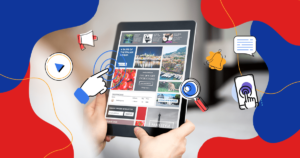When it comes to search engine optimization (SEO), most businesses and developers focus on core elements like keywords and relevant content.
And they should. But there are so many websites and pages on the internet, that it’s impossible for professionals at Google, for example, to scour through them individually checking your SEO efforts.
Instead, search engines rely on bots and algorithms to determine a page’s content and whether it’s relevant to a specific search query.
Crawlability and indexability refer to how well these bots can navigate and understand your website.
So, if you can improve your site’s crawlability and indexability, you can get better SEO.
This article will dive deep into these terms and what they mean. We’ll also discuss how to optimize your pages accordingly.
What is Crawlability?
Web crawlers simply follow links on websites to see where they lead.
These crawlers will follow the link, scan the content, and then index the page based on what it found. If the page has links to other sites and pages, the crawler will follow those as well.
So, crawlability refers to how well a bot can scan and index your pages.
The more crawlable your site, the easier it is to index, which helps improve your rankings in SERPs.
Keep in mind that web crawlers are constantly working, and they’ll come back to your website regularly to see if it has changed or updated.
If you adjust your site frequently, crawlers will come back to index the pages more often.
Once a crawler registers a change, it will send the update to the index. This way, only current content will pop up on search results.
Although you may think that your site is inherently crawlable, there are a few reasons why a bot can’t navigate through your pages.
For example, if there are too many broken links or redirects, the bot will get stopped in its tracks.
What is Indexability?
While web crawlers can follow links and navigate pages, their ability to figure out what’s on the page is pretty limited.
For example, these bots can’t “see” images or videos since they only pay attention to HTML text.
So, you could have tons of visual content on your pages, but Google and other search engines won’t know what the content is about, so they won’t index your site correctly.
Indexability is where SEO comes into play.
Using keywords and tags helps the crawlers analyze and understand your content better.
So, the more you invest in SEO, the more indexable your site.
Crawlability vs. Indexability: How Do They Affect SERP Ratings?
Overall, you want your site to be as crawlable and indexable as possible.
The easier it is for bots to follow links and understand what’s on your pages, the more likely they’ll rank those pages higher on SERPs.
While both options are vital for SEO purposes, indexability is a bit more valuable.
If a search engine doesn’t know what’s on a page, it won’t know whether the content is relevant to a specific search.
So, your ranking will take a bigger hit if you don’t invest in technical SEO strategies.
We should point out that improving crawlability and indexability has nothing to do with the user.
Web crawlers don’t pay attention to your page layout, color scheme, branding, and other visual elements.
That said, because search engines have so many pages to scan and index, making the bot’s job more efficient will help you rank higher overall.
How Do You Optimize Crawlability and Indexability?
Let’s look at some elements that can affect your crawlability and indexability so that you know how to optimize your site accordingly.
1. Improving your sitemap
The Problem: you have a disorganized sitemap without a clear hierarchy of pages.
It’s hard to get from one page to another, and some pages may not be accessible via links. Instead, you have to enter the URL to reach the page.
When building a website, it helps to create a sitemap of how each page relates to the others.
There should also be a natural hierarchy and flow to your site.
Think of this hierarchy as headers for an article. For example, the H1 tags would be the buttons on your home page (i.e., products, about us, contact us, etc.).
From there, you can expand each section into subsections and so on.
If you don’t have a clear and understandable hierarchy, it’s much harder for web crawlers to create a complete sitemap.
In some cases, the bots may not index all of your pages, which hurts each page’s ranking.
The Solution
The easiest way to help Google navigate your website is to submit a sitemap.
This way, you’re giving Google a complete picture of your site rather than letting the bots figure it out for themselves.
If you submit a sitemap, make sure to update it regularly. Otherwise, you could negatively impact your crawlability.
2. Using internal links in a smart way
The Problem: Your site doesn’t use many internal links, and the ones you do use are unrelated to the content on the page.
Some links are outdated and broken, or they create a redirect loop that stops a crawler from moving further.
Just as the internet is a collection of interconnected links, your website should be too.
However, it’s not enough to add internal links within your content — you have to optimize them as well.
For example, if you wrote a blog post about something related to content on another page, you should link back to that post.
Doing this shows the crawlers that all of your pages are connected and interrelated. Overall, the more links you have, the faster and easier it is to crawl your entire website.
Another point to remember is that you should be able to link to every page from somewhere on your site.
Isolated pages make it harder for the bots to figure out that they’re part of your website.
The Solution
Audit your site and see where you can add more internal links.
As you add content to your pages, be sure to update your link structure accordingly.
Also, double-check every connection to ensure that it’s relevant and active. And update any broken links ASAP.
3. Choosing the best hosting service
The Problem: Some pages take too long to load, so they time out before a bot can crawl or index it.
Even if you have the best site in the world, you won’t get much traffic if you use a subpar hosting service.
High-quality hosts can ensure that your site loads quickly and reliably no matter what.
Not only can faster speeds help with crawlability, but they can also lower your bounce rate and help increase your overall traffic.
The Solution
If your current host is too slow, upgrade to a better one (like Stage).
Conduct speed checks regularly to see how well your hosting service is keeping up with demand.

4. Optimizing SEO Tags
The Problem: Pictures don’t have alt text, and pages are missing title and meta tags.
Search engine optimization is a comprehensive strategy that uses a collection of minor elements.
Individually, a single tag or link won’t make or break your website. However, too many issues and you’ll get knocked down a few spots in SERPs.
When it comes to crawlability, you need to optimize all of your visual content.
Every picture should have alt text that describes what it is. This text can’t be something random like a photo ID number. Instead, you should use targeted keywords as much as possible.
You should add descriptions to any video content on your pages as well.
Since web crawlers can’t watch the content, the text description tells the bot what the video is about so that it can index it correctly.
The Solution
You can use site auditing tools to pinpoint where you’re missing SEO tags.
Once you’ve discovered all the empty slots on your site, you can go in and fill them with keywords and optimized content.
5. Updating coding and scripts
The Problem: Your site uses outdated code like AJAX or Javascript.
Web crawlers can’t navigate these systems, so they can’t index your pages.
The internet has come a long way from its early days, and there are many modern coding options to build your website. If you’re using outdated technology, now is the time to upgrade.
The Solution
Update your website to a modern code that works with web crawlers.
Wrap Up: Crawlability is all about Following Links
That is why you need to build a strong network of backlinks.
A backlink is from one website to another, so it’s different from an internal link (one page to another). If you’re not using enough backlinks, you could get hurt in the rankings.
In this blog post, find out more about backlinks and how to use them effectively!


![[ROCK NA] [EBOOK SEO] Complete Guide](https://rockcontent.com/wp-content/uploads/2024/06/banner_Search-Engine-Optimization.png)






